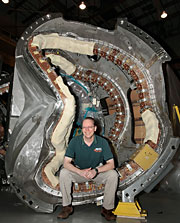- Number 332 |
- March 7, 2011
Stellarator Man: From Tokamaks to Stellarators
Life's turns are as interesting and complex as the twists in a stellarator's magnetic loops.
Just ask DOE Princeton Plasma Physics Laboratory (PPPL) physicist David Gates, the Stellarator Physics Leader at PPPL and a visiting professor last summer at the National Institute for Fusion Science (NIFS) in Japan.
The longtime tokamak researcher has turned his eye from the toroidal symmetry of tokamaks to the curvy, complicated magnets — and the promise of steady-state operations — of stellarators.
Tokamaks and stellarators are types of experimental fusion energy machines in which plasma — a hot, electrically charged gas that is the fuel for fusion energy production — is confined by magnetic fields inside a vacuum chamber. In stellarators, external magnetic coils generate twisted field lines around the inside of the vacuum chamber to contain the plasma; in tokamaks, there are two sets of magnets, an external set surrounding the vacuum chamber and an internal transformer that drives current in the plasma through pulses, creating twisted magnetic field lines.
Gates, who received a Ph.D. from Columbia University in 1993, had worked on tokamaks since graduate school. "Tokamaks are the most successful fusion concept in the sense that they have come closest to achieving fusion conditions," he says.
Still, he admits to being "fairly skeptical" that a tokamak can lead to a reactor. Generally, tokamaks operate in a pulsed mode and are subject to disruptions. A practical fusion reactor will require continuous operation and control over plasma disruptions. "Stellarators offer the best possibility for steady-state operation," says Gates, an expert in plasma controls who had previously worked on PPPL’s National Spherical Torus Experiment.
Gates notes that researchers have not been able to operate tokamaks in steady state without getting plasma instabilities that lead to disruptions. Once plasma disrupts, the fusion reaction ends. "The upside of a stellarator is that the helical (twisted) field is now imposed by external coils so you don't need a current — you don't need to drive a current anymore. That whole requirement goes away," says the stellarator convert. "That makes it easy to imagine a steady-state device."
Historically stellarators — which are three-dimensional (3-D) — lacked good confinement because researchers did not know how to handle 3-D systems. Theoretical and computer advances during the past two decades transformed the picture, making stellarators an attractive option.
Gates's interest in stellarators was piqued indirectly. While conducting tours for PPPL, he brushed up on his stellarator knowledge to better answer visitors' questions about the National Compact Stellarator Experiment (NCSX), now mothballed. "I wanted to answer their questions so I read about the stellarator and the more I read about it the more fascinated I became," says Gates, who joined PPPL's research staff nearly 13 years ago after working as a research associate for four years at Culham Laboratory in the U.K. "[Today's modern] stellarators are potentially a break-through for fusion."
He admits there are complexities associated with stellarator research, "but, of course, it's the kind of complexity that looks like a good challenge to me." Gates is now responsible for leading PPPL's experimental stellarator physics activities, including collaboration on off-site stellarator experiments and providing physics input to stellarator engineering tasks. Along the stellarator path, Gates was offered the prestigious professorship in Japan, where he spent three months working on the Large Helical Device (LHD), a type of stellarator called a heliotron.
It's no surprise Gates identifies with the flexible Mr. Fantastic. Asked what superhero he would be if given the chance, he pauses and says, "The rubber guy in the Fantastic Four -- Mr. Fantastic. He was smart and he thought his way out of situations. If he was stuck, he was flexible."
Maybe it pays to be flexible in life, just as it does in fiction for the genius scientist superhero from Marvel Comics.
Otherwise, how else would a lifetime tokamak man end up in stellarators?
Submitted by DOE's Princeton Plasma Physics Laboratory

